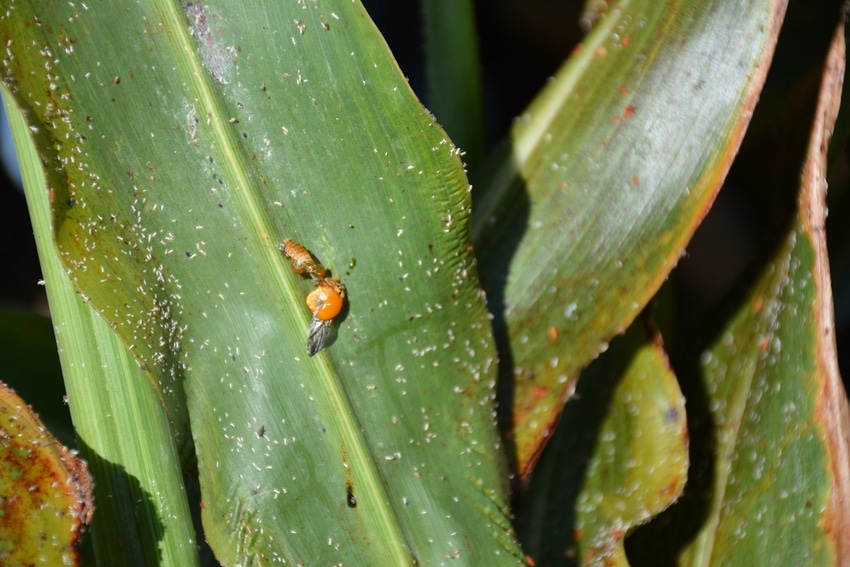
A New Mexico State University entomologist is warning farmers across the state to be on the lookout for the arrival of a new pest that potentially could wreck havoc on sorghum fields within the state.
Jane Pierce, agronomic entomologist at New Mexico State University, warns that the sugarcane aphid that has been plaguing South Texas the past two seasons and has been migrating north into the Southern Plains will eventually make its way into eastern New Mexico, most probably around Portales.
In Texas, economists and researchers estimate the sugarcane aphid has cost Texas sorghum growers more than $38 million in losses since it was first detected along the mid-coast region of the state late in 2013. Pierce says sugarcane aphids have already been found in Oldam County, Texas, just across the border and chances are good they have already migrated west into New Mexico.
For the latest on southwest agriculture, please check out Southwest Farm Press Daily and receive the latest news right to your inbox.
Last year sugarcane aphids were detected in grain sorghum and Johnsongrass, or Sorghum halepense, in the Texas Panhandle, the Plainview area, and later were reported in fields near Lubbock. Cases of sugarcane aphids in sorghum were reported even as far north as Oklahoma late last year and some entomologists believe they have or will soon be widely spread across Kansas grain fields.
Pierce says sugarcane aphids should not be confused with yellow sugarcane aphids or greenbugs. Sugarcane aphids, which have also been called white aphids, are more prolific and can quickly increase to dense populations once established near the base of grain sorghum. Within 10 days to a week, they can reach threshold levels and by week three can become so dense on sorghum that thick honeydew begins to collect on lower leaves.
Different aphid
Unlike other common aphid species that feed on sorghum, sugarcane aphids have dark, paired, tailpipe-like structures, called cornicles, at the rear, and their tarsi (feet) are dark at high magnification. The dark cornicles and tarsi contrast distinctively with the lighter body color of the sugarcane aphid. The sugarcane aphid colonizes the lower surfaces of lower leaves first and then advances to the upper leaves.
Aphid feeding causes yellow to red or brown leaf discolorations on both sides. The honeydew may also support the growth of black, sooty mold fungus. Infestations of seedlings can kill young grain sorghum plants; later infestations can prevent grain from forming.
"Sugarcane aphid is a new aphid pest of sorghum. This aphid either expanded its diet from eating sugarcane to eating sorghum, or it came in as a new biotype," Pierce says.
The sugarcane aphid is problematic in warmer regions like South Texas because they overwinter on Johnsongrass and other sorghum-type host plants, giving them the chance to populate young sorghum plants quickly after emergence. But because of New Mexico's colder winters, the chance of aphids surviving the cold season is reduced.
Plant specialists warn that aphids still may repopulate fields quickly in late spring and will thrive once summer temperatures begin to climb. Once they establish a foothold in a healthy crop, these pests can rapidly increase in density and have the potential of greatly reducing yields and the honeydew may make harvesting difficult or impossible.
The only successful campaign includes regular scouting determine when aphid field population numbers reach threshold.
On the brighter side, Pierce says new insecticides have been developed to fight the threat of heavy sugarcane populations. If an improved non-neonicotinoid insecticide is applied at the recommended economic threshold of 50 to125 aphids per leaf, growers can generally see sufficient control with just one application. But of the successful insecticides developed to fight the aphid, none have been approved for use in New Mexico. A special Section 18 approval from the Environmental Protection Agency would be required before limited use is available within the state.
Pierce says once the aphid has been positively identified in New Mexico, state agriculture department officials can initiate action that should result in the issue of special permits for the use these new insecticides.
Last year in Texas and Louisiana, Dow Chemical's Transform provided outstanding results in combating sugarcane infestations in grain sorghum. Bayer CropScience has also developed a new insecticide, Sivanto, that has proven successful in trials. Both would require special Section 18 emergency use approval before producers could use the products in New Mexico.
"Growers can see losses of 25 to 50 percent from heavy infestations. Some fields (in South Texas) have been so bad that growers have abandoned them completely," Pierce said, so an aggressive scouting plan remains the best tool for sorghum producers.
She encourages sorghum growers to scout early and regularly, especially on the underside of lower sorghum leaves, and recommends that producers talk with their county agents to keep up with the latest developments as the growing season progresses.
About the Author(s)
You May Also Like




